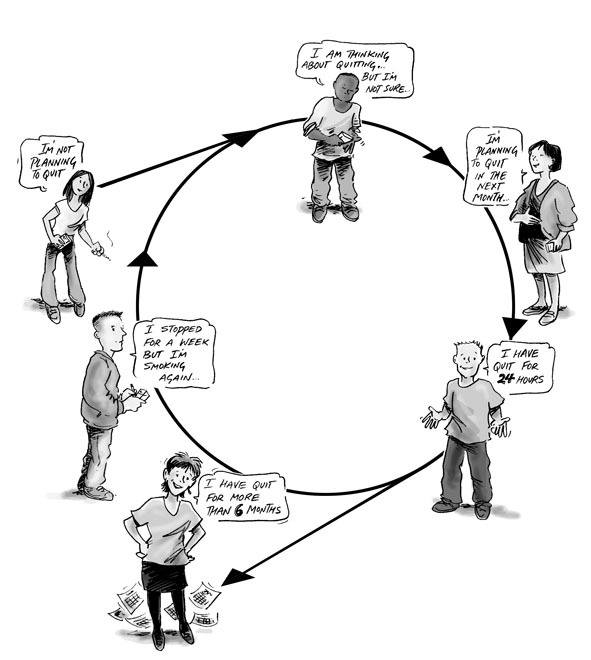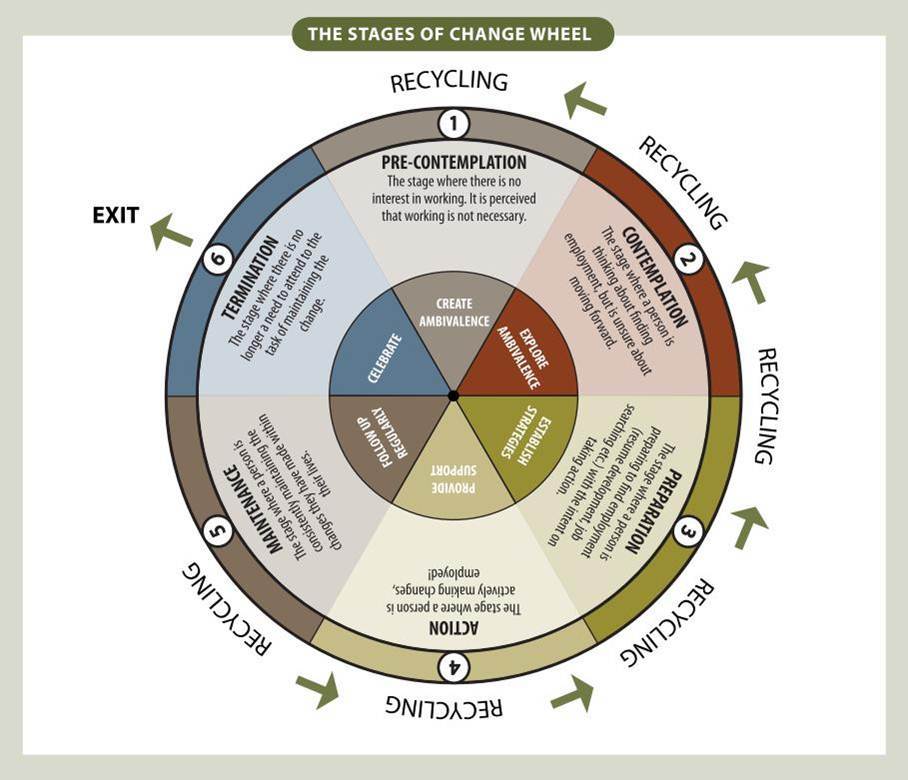There’s no doubt that change can be difficult. Old habits are hard to shift, and adopting a new lifestyle can feel like an uphill battle. However, understanding the Stages of Change Model can help you implement lasting change in your life.
The Stages of Change Model explains the science behind personal transformation. You’ll discover how and why some changes stick while others don’t last and how long it takes to build new habits.
Table of Contents
What Are the Stages of Change Model?
Developed by researchers J.O. Prochaska and Carlo C. DiClemente over 40 years ago[1] and outlined in their book Changing For Good, the Stages of Change Model, also known as the Transtheoretical Model, was formed as a result of the authors’ research with smokers.
Prochaska and DiClemente were originally interested in why some smokers could quit on their own, whereas others required professional help. Their key conclusion was that smokers (or anyone else with a bad habit) quit only when they are ready to do so.
Here’s an illustration done by cartoonist and illustrator Simon Kneebone[2] about the different stages a smoker experiences when they try to quit smoking:
The Stages of Change Model looks at how these conscious decisions are made. It emphasizes that people can spend a long time stuck in a stage, and some may never reach their goals.[3]
The model has been applied in the treatment of smoking, alcoholism, and drugs. It is also a useful way of thinking about any bad habit. Social workers, therapists, and psychologists draw on the model to understand their patients’ behaviors and to explain the stages of change process to the patients themselves.
The key advantages of the model are that it is simple to understand, is backed by extensive research, and can be applied in many situations.
The Stages of Change Model is a well-established psychological model that outlines 6 stages of personal change:
- Pre-contemplation
- Contemplation
- Preparation
- Action
- Maintenance
- Termination
How Are These Stages Relevant to Changing Habits?
To help you visualize the stages of change and how each progresses to the next one, please take a look at this wheel:
Let’s look at the six stages of change and an example showing how the model works in practice.
Stage 1: Pre-contemplation
In the pre-contemplation stage, an individual does not plan to make any positive changes in the next six months. This may be because they are in denial about their problem, feel too overwhelmed to deal with it, or are discouraged after multiple failed attempts to change.
For example, someone may know they need to start exercising but cannot find the motivation to do so. They might keep thinking about the last time they tried (and failed) to work out regularly. Only when they start to realize the advantages of making a change will they progress to the next stage.
Stage 2: Contemplation
In the contemplation stage of change, the individual starts to consider the pros and cons of changing. They start to acknowledge that altering their habits would probably benefit them, but they spend a lot of time thinking about the downside of doing so. This stage can last for a long time – possibly a year or more.
You can think of this as the procrastinating stage. For example, an individual begins to seriously consider the benefits of regular exercise but feels resistant when they think about the time and effort involved. When the person starts putting together a concrete plan for change, they move to the next stage.
The key to moving from this stage to the next is the transformation of an abstract idea into a belief (e.g., from “Exercise is a good, sensible thing to do” to “I personally value exercise and need to do it.”)[4].
Stage 3: Preparation
People in this stage start toput a plan in placeto move away from the status quo
. This stage is brief, lasting a few weeks. For example, they may book a session with a personal trainer and enroll in a nutrition course.
Someone who drinks to excess may make an appointment with a drug and alcohol counselor; someone with a tendency to overwork might start planning ways to devise a more realistic schedule.
Stage 4: Action
At this point in the Stages of Change Model, the individual must implement their step-by-step plan. This stage typically lasts for several months and involves many small steps. In our example, the person would begin attending the gym regularly and overhauling their diet.
Stage 4 is when the person’s desire for change becomes noticeable to family and friends. However, in truth, the change process began a long time ago. If someone you know seems to have suddenly changed their habits, it’s probably not so sudden after all!
You can learn how to take action on your goals in this article.
Stage 5: Maintenance
After a few months in the action stage, the individual will start to think about how they can maintain their changes in the long term and make lifestyle adjustments accordingly. For instance, someone who has adopted the habit of regular workouts and a better diet will be vigilant against old triggers (such as eating junk food during a stressful time at work) and make a conscious decision to protect their new habits.
Unless someone actively engages with Stage 5, their new habits are liable to come unstuck. Someone who has stuck to their new habits for months—perhaps a year or longer—may enter the final stage.
Maintenance can be challenging because it entails developing a new set of habits to lock change in place. For instance, someone who is maintaining their new gym-going habit may have to start improving their budgeting skills to continue to afford their gym membership.
Stage 6: Termination
Not many people reach this stage, which is characterized by a complete commitment to the new habit and a certainty that they will never go back to their old ways. For example, someone may find it hard to imagine giving up their gym routine and feel ill at the thought of eating junk food regularly.
However, for most people, it’s normal to stay in the maintenance period indefinitely. This is because it takes a long time for a new habit to become so automatic and natural that it sticks forever with little effort.
For example, an ex-smoker will often find it hard to resist the temptation to have “just one” cigarette, even a year or more after quitting. It can take years for them to truly reach the termination stage, at which point they are no more likely to smoke than a lifelong non-smoker.
How Long Does Each Stage Take?
You should be aware that some people remain in the same stage for months or even years. Understanding this model will help you be more patient with yourself when making a change. If you try to force yourself to jump from contemplation to maintenance, you’ll end up frustrated. On the other hand, if you take a moment to assess where you are in the change process, you can adapt your approach.
If you need to make changes quickly, and you are finding it hard to progress to the next stage, it’s probably time to get some professional help or adopt a new approach to forming habits.
Limitations of the Stages of Change Model
The model is best applied when you decide in advance precisely what you want to achieve and know exactly how you will measure it (e.g., the number of times per week you go to the gym or the number of cigarettes smoked per day). Although the model has proven useful for many people, it does have limitations.
Require the Ability to Set a Realistic Goal
For a start, there are no surefire ways of assessing where you are in the process—you just have to be honest with yourself and use your own judgment. Second, it assumes that you are physically capable of making a change, whereas you might either need to adjust your goals or seek professional help.
If your goal isn’t realistic, it doesn’t matter whether you follow the stages—you still won’t get results. You need to decide for yourself whether your aims are reasonable.[5]
Difficult to Judge Your Progress
The model also assumes that you can objectively measure your successes and failures, which may not always be the case.
For instance, you are trying to get into the habit of counting calories as part of your weight-loss efforts. However, even though you may think you are recording your intake properly, you might be over or underestimating.
Research shows that most people think they are getting enough exercise and eating well but really aren’t as healthy as they believe. The model doesn’t consider this possibility, meaning that you could believe yourself in the action stage yet aren’t seeing results.
Therefore, if you are serious about making changes, it may be best to get some expert advice so that you can be sure the changes you are making really will make a positive difference.
Conclusion
The Stages of Change Model can be a wonderful way to understand the change in yourself and others. While it has some limitations, the Stages of Change Model helps visualize how you go through changes so you know what to expect when trying to change a habit.
Featured photo credit: Ian Parker via unsplash.com
Reference
| [1] | ^ | Psych Central: Stages Of Change |
| [2] | ^ | Simon Kneebone: Tobacco and Mental Illness Project |
| [3] | ^ | Boston University School Of Public Health: The Transtheoretical Model (Stages Of Change) |
| [4] | ^ | Psychology Today: 5 Steps To Changing Any Behavior |
| [5] | ^ | The Transtheoretical Model: Limitations Of The Transtheoretical Model |














































